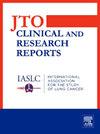美国肺癌筛查的早期经验——国家数据链接的创建:简要报告
IF 3.5
Q2 ONCOLOGY
引用次数: 0
摘要
自2013年以来,肺癌筛查已被美国预防服务工作组推荐。2015年初,医疗保险和医疗补助服务中心的覆盖范围决定要求向医疗保险和医疗补助服务中心批准的注册中心提交数据,以便接收筛查费用。只有美国放射学院的肺癌筛查登记处(LCSR)获得了这一目的的批准。一些LCSR因素,如种族、民族、下游诊断程序和癌症结局,被低估了。为了解决低报问题,我们将LCSR的数据与2015年至2021年的医疗保险和监测、流行病学和最终结果癌症登记数据联系起来。我们创建了两个不同的65岁及以上的个体队列:(1)在至少一次lcsr报告的筛查中登记了医疗保险按服务收费计划的A部分和B部分覆盖的人;(2)在至少一次lcsr报告的筛查中居住在监测、流行病学和最终结果集区内的医疗保险受益人(无论是否按服务收费或管理医疗)。我们将相关队列中个体的特征与65岁及以上LCSR中所有个体的特征进行了比较。结果关联数据中的人口学、吸烟史和筛查检查数据元素与总体LCSR数据元素基本相似。在这些结果的基础上,相关人群似乎普遍代表了LCSR中的老年人。这些独特的数据联系为更好地了解美国肺癌筛查的早期实施提供了前所未有的机会。本文章由计算机程序翻译,如有差异,请以英文原文为准。
The United States’ Early Experience With Lung Cancer Screening—Creation of a National Data Linkage: A Brief Report
Introduction
Lung cancer screening has been recommended by the United States Preventive Services Taskforce since 2013. The Centers for Medicare and Medicaid Services coverage decision in early 2015 required data submission to a Centers for Medicare and Medicaid Services–approved registry for facilities to receive payment for screening. Only the American College of Radiology’s Lung Cancer Screening Registry (LCSR) received approval for this purpose. Some LCSR elements, such as race, ethnicity, downstream diagnostic procedures, and cancer outcomes, were underreported.
Methods
To address underreporting, we linked data from the LCSR to Medicare and Surveillance, Epidemiology, and End Results cancer registry data from 2015 to 2021. We created two different cohorts of individuals aged 65 years and older: (1) those who were enrolled in Medicare fee-for-service plans with parts A and B coverage at the time of at least one LCSR-reported screen, and (2) Medicare beneficiaries (regardless of whether fee-for-service or managed care) living within a Surveillance, Epidemiology, and End Results catchment area at the time of at least one LCSR-reported screen. We compared the characteristics of individuals in the linked cohorts with those of all individuals in the LCSR aged 65 years and over.
Results
Demographic, smoking history, and screening examination data elements in the linked data were generally similar to those in the overall LCSR.
Conclusions
On the basis of these results, the linked populations seem to be generally representative of older individuals in the LCSR. These unique data linkages provide an unprecedented opportunity to better understand the early implementation of lung cancer screening in the United States.
求助全文
通过发布文献求助,成功后即可免费获取论文全文。
去求助
来源期刊

JTO Clinical and Research Reports
Medicine-Oncology
CiteScore
4.20
自引率
0.00%
发文量
145
审稿时长
19 weeks
 求助内容:
求助内容: 应助结果提醒方式:
应助结果提醒方式:


